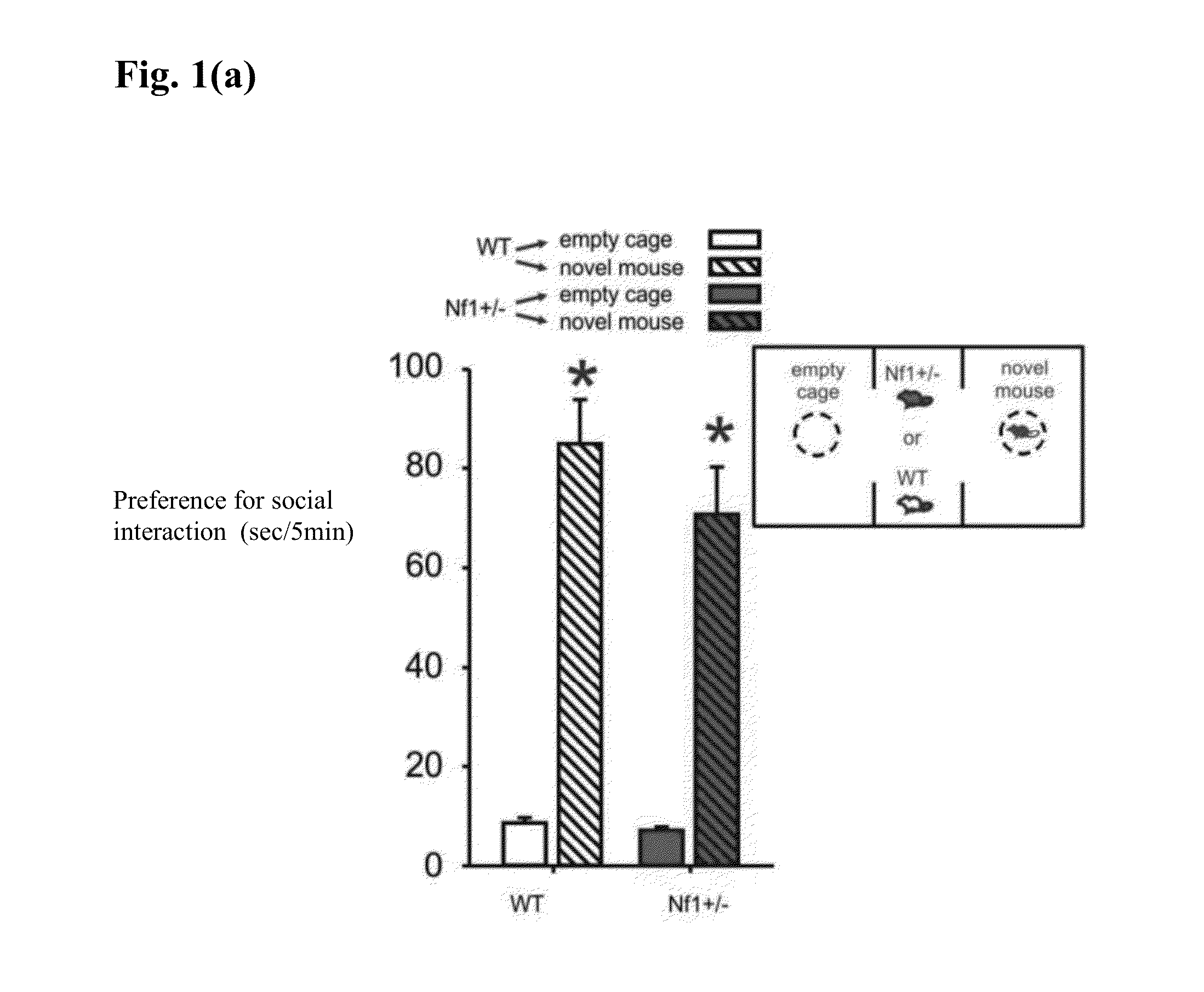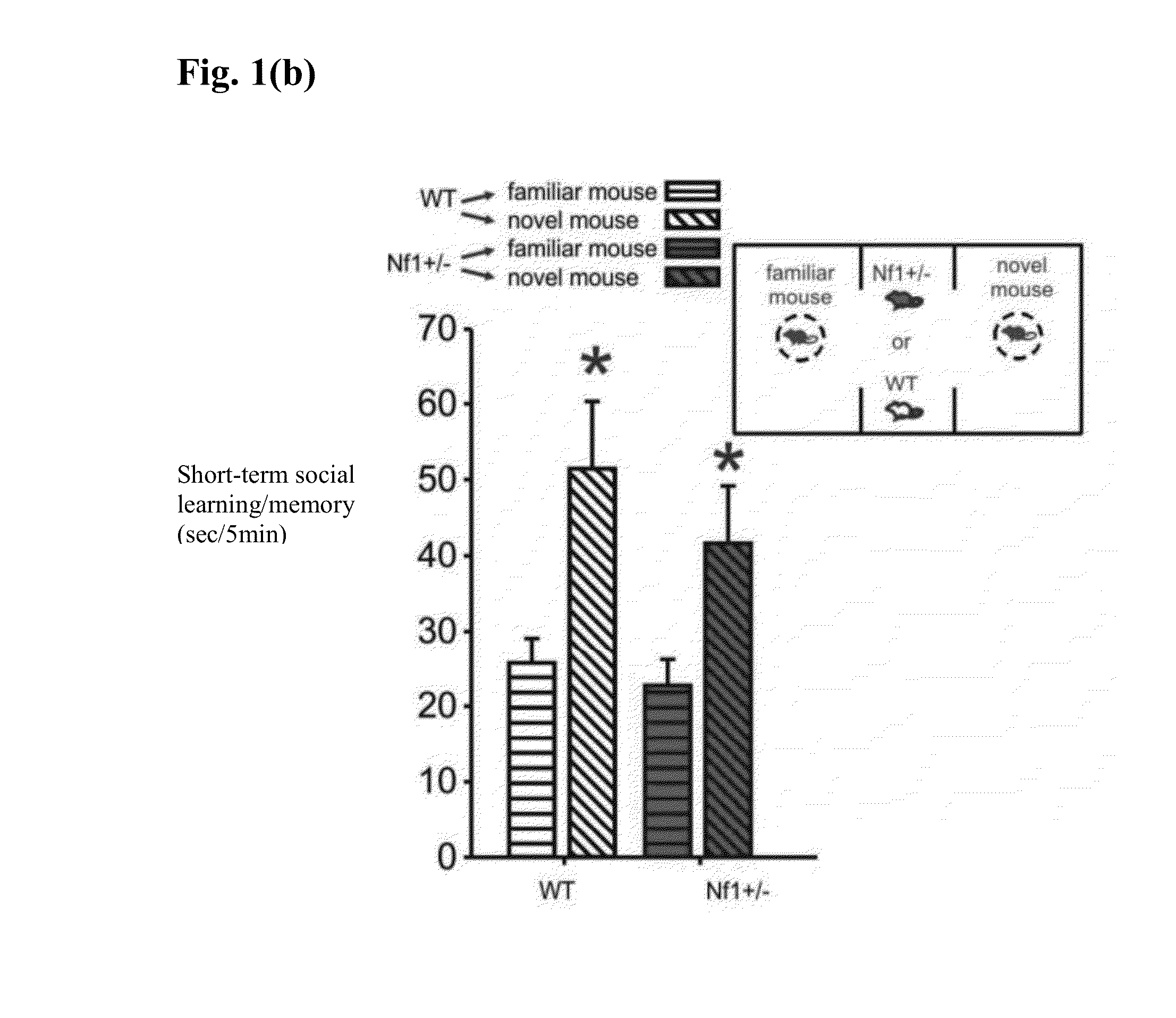Treatments for social learning disorders
a social learning disorder and treatment method technology, applied in the field of neuroscience and psychiatry, can solve the problems of difficult deciphering of other complex phenotypic, genetic and molecular mechanisms involved in the regulation of social learning behaviors, and achieve the effects of reducing the strength and duration of ras signal transduction, restoring mapk dependent functions, and positively regulating mapk activation
- Summary
- Abstract
- Description
- Claims
- Application Information
AI Technical Summary
Benefits of technology
Problems solved by technology
Method used
Image
Examples
embodiments
[0026]Much of human behavior is learned or influenced observationally through modeling. More specifically, from observing others one forms an idea of how new behaviors are to be performed, and on later occasions this coded information serves as a guide for action. Just as there are learning disabilities that interfere with academic performance, there are learning disabilities that interfere with acquiring and utilizing social behavior that enable us to function in a society. Children with learning disabilities affecting social skills have difficulty reading the social cues of others. They may not recognize emotional facial expressions or body language that gives clues to guide social behavior. As such a child with this learning disability may not appreciate when they have insulted, upset or frustrated another person. If they cannot recognize the facial expression, then they are at a loss for modulating their own behavior in response. Hence they may carry on with offensive or inappro...
examples
[0039]Methods. All experiments were conducted using male mice. Wild-type, Nf1+ / −, Nf1+ / − / Pak1− / − and Pak1− / − mice bred on a C57BL / 6J background were tested at approximately 10 weeks of age. The social interaction test and elevated plus-maze were conducted as previously described (Noll et al. (2007); Shekhar et al. (1993)). Four sessions were conducted including (1) acclimation (two empty cages), (2) preference for social interaction (novel mouse, empty cage), (3) short-term social learning (familiar mouse, novel mouse), and (4) long-term social learning (familiar mouse—24 hr. later, novel mouse). Anxiety-like behavior / avoidance learning was measured using two five minute trials. For the olfactory habituation test, mice were assessed for time spent sniffing cotton tipped swabs. The time spent sniffing cotton swabs scented with either water, almond extract or novel mouse was measured. Following the behavioral tests, mice from each respective strain were used to prepare coronal slices,...
example 2
Nf1+ / − And Pak1− / − Double Knockout Animals
Behavioral Tests
[0054]The genetic intercross (Nf1+ / − / Pak1− / −) was tested to see if it would restore the learning deficits seen in Nf1+ / − mice. We found that Nf1+ / −, Nf1+ / − / Pak1− / −, and Pak1− / − strains show no differences in their preference for social interaction, [F1, 26=100.5, p=0.001 for novel verses empty cage; FIG. 3a] or short-term social learning [F1, 26=32.6, p=0.001 for novel verses familiar mouse; FIG. 3b]. However, as before, deficits were seen in Nf1+ / − mice in long-term social learning [F1, 26=7.3, p=0.01; FIG. 3c], but importantly, co-deletion of Pak1 in Nf1+ / − mice (Nf1+ / − / Pak1− / − mice) clearly restored this learning deficit. Similar to Applicants' previous results with Nf1+ / − mice, no differences in anxiety, avoidance learning or olfaction in the Nf1+ / − / Pak1− / − mice were detected (FIG. 3d-f). Consistent with the biochemical and behavioral effects, co-deletion of Pak1 completely normalized both the increases in sIPSC and mIPS...
PUM
| Property | Measurement | Unit |
|---|---|---|
| pH | aaaaa | aaaaa |
| pH | aaaaa | aaaaa |
| pH | aaaaa | aaaaa |
Abstract
Description
Claims
Application Information
 Login to View More
Login to View More - R&D
- Intellectual Property
- Life Sciences
- Materials
- Tech Scout
- Unparalleled Data Quality
- Higher Quality Content
- 60% Fewer Hallucinations
Browse by: Latest US Patents, China's latest patents, Technical Efficacy Thesaurus, Application Domain, Technology Topic, Popular Technical Reports.
© 2025 PatSnap. All rights reserved.Legal|Privacy policy|Modern Slavery Act Transparency Statement|Sitemap|About US| Contact US: help@patsnap.com



